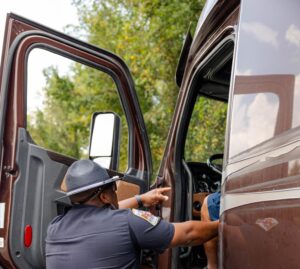WASHINGTON, D.C. — The U.S. Department of Transportation (DOT) announced Thursday the federal government’s new National Roadway Safety Strategy (NRSS), a roadmap for addressing the national crisis in roadway fatalities and serious injuries.
The plan includes a call for automatic emergency braking on both cars and heavy-duty tractors, something that has been controversial among members of the trucking industry.
Almost 95 percent of the nation’s transportation deaths occur on its streets, roads and highways, according to DOT statistics. While the number of annual roadway fatalities declined for many years, progress plateaued over the last decade with fatalities rising during the pandemic.
“We cannot tolerate the continuing crisis of roadway deaths in America. These deaths are preventable, and that’s why we’re launching the National Roadway Safety Strategy (NRSS) today – a bold, comprehensive plan, with significant new funding from President Biden’s Bipartisan Infrastructure Law,” U.S. Transportation Secretary Pete Buttigieg said. “We will work with every level of government and industry to deliver results, because every driver, passenger and pedestrian should be certain that they’re going to arrive at their destination safely, every time.”
The DOT, as part of the NRSS, is adopting the “Safe System Approach,” which acknowledges both human mistakes and human vulnerability, and designs a redundant system to protect everyone by preventing crashes and ensuring that when they do happen they do not result in serious injury or death.
The DOT will use a five-pronged model to address safety: safer people; safer roads; safer vehicles; safer speeds and post-crash care.
A few of the key actions include:
- Work with states and local road owners to build and maintain safer roadways through efforts, including updates to the Manual on Uniform Traffic Control Devices, a Complete Streets Initiative to provide technical assistance to communities of all sizes and speed limit setting.
- Leveraging technology to improve the safety of motor vehicles on U.S. roadways, including rulemaking on automatic emergency braking and pedestrian automatic emergency braking, along with updates to the New Car Assessment Program.
- Investing in road safety through funding in the Bipartisan Infrastructure Law, including $6 billion Safe Streets and Roads for All program, hundreds of millions for behavioral research and interventions and $4 billion in additional funding for the Highway Safety Improvement Program.
The strategy was developed in coordination with the DOT’s Executive Safety Council, led by Deputy Transportation Secretary Polly Trottenberg.
The NRSS builds on efforts from across DOT’s three roadway safety agencies: the Federal Highway Administration (FHA), National Highway Traffic Safety Administration (NTSB) and the Federal Motor Carrier Safety Administration (FMCSA).
“The Roadway Safety Action Plan is designed to focus all of DOT’s resources, authorities and incredible expertise, working with our stakeholders, to combat the tragic number of fatalities and serious injuries we see on U.S. roadways – from our largest cities and towns to rural and tribal communities all across the country,” Trottenberg said.
“Unfortunately, many roads are not designed to ensure safe travel at safe speeds for everyone, especially the most vulnerable road users,” said FHA Deputy Administrator Stephanie Pollack. “The Bipartisan Infrastructure Law provides a tremendous opportunity for FHA to work closely with state, local and tribal partners to put increased transportation funding to work incorporating safety for all users into every federally-funded road project.”
“FMCSA is committed to reducing Commercial Motor Vehicle fatalities and overall fatalities. We will work across the DOT to coordinate proactive compliance and outreach programs and work collaboratively with all stakeholders,” said FMCSA Executive Director and Chief Safety Officer Jack Van Steenburg. “Our goal is to prevent crashes and preserve the quality of life for all roadway users across America. Zero is our goal.”
The Trucker News Staff produces engaging content for not only TheTrucker.com, but also The Trucker Newspaper, which has been serving the trucking industry for more than 30 years. With a focus on drivers, the Trucker News Staff aims to provide relevant, objective content pertaining to the trucking segment of the transportation industry. The Trucker News Staff is based in Little Rock, Arkansas.














